Identify Your AGA
HOME | Technical & Spares | Identify your aga
Need an accessory for a vintage AGA?
If you want to spice up your classic AGA or have just acquired one, we have a large range of accessories that will fit. Go to the AGA Cookshop.
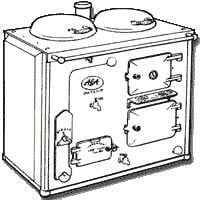
Swedish Mark 1 cooker 1929-1930
Distinguishing features
- Long tank neck.
- Knob rail brackets.
- No heat gauge above roasting oven.
- Trade Mark and lettering in blue enamel.
- The word “Patent” below the Trade Mark.
- Coil oven door and ashpit door handles.
- High position of bottom oven.
- Volute ashpit door clamp.
- Cream vitreous enamelled base plate flush with front plate.

Swedish Mark 2 cooker 1930-1932
This model was imported from Sweden from 1930 to 1932 and while similar in many respects to the Mark 1, it was distinguished from it by:
- The slightly larger top oven.
- The lower position of the bottom oven the bottom edge of which was now in line with the bottom edge of the asphalt door.
- The black edges to the base plate.
- The bottom edge of the front plate was bevelled flush with the front edge of the base plate.
- The Trade mark and the word “patent” were in chocolate brown enamel .
- The coil handle was retained on the ashpit door but the oven doors now had the familiar lug type handles cast in one with the doors.
- The ashpit door clamp was replaced by the now familiar ball catch.
- A red and cream “signal” ball took the place of the thermometer in the top oven door (this “signal” ball may also have since been replaced by a circular plaque).
- The heat gauge, calibrated in degrees, above the top oven door (may since have been replaced with one of the modern type)
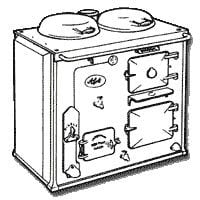
Model D stove 1932-1934
Known as the long barrel Model D (or LBD) this AGA was made in Great Britain between 1932 and 1934. It is similar to the Swedish Mark II stove except that:
- The word “patent” was omitted from below the Trade Mark.
- The grille-pattern trivet was replaced by a plain one.
- The chromium plated T-shaped ashpit door handle replaced the coil handle.
- The front rail was made in one piece, with no brackets.
- The short tank neck (may since have been removed).

Model D cooker 1934-1941
In March 1934, the AGA cooker was redesigned and the length of the inner barrel, and, in fact, the whole fire unit, was shortened. Originally known as the “De Luxe” model and later as Model 62 (since it cost £62) it eventually became known as Model SBD (short barrel D) to distinguish it from its predecessors all of which, both Swedish and English were generally referred to henceforth as LBD (long barrel D), it was distinguished from other earlier models by:-
- The heightened position of the ashpit door which was reshaped to cover the auxiliary air inlet. (This auxiliary air inlet on LB stoves was positioned at the bottom eight-hand corner of the front plate). On some of the earlier SBD models a spin-wheel control was fitted to the auxiliary air inlet whereas in later models this control was omitted. The ashpit door had an additional hole, near the top, through which the grate could be riddled. The method however, was not entirely satisfactory and instructions were later issued for this hole to be plugged.
- The chromium plated front rail was dispensed with and the top plate was extended forwards to take its place.


Model B cooker 1935
For a short while a single-oven AGA stove was produced and it was originally known as Model 35 (it cost £35) and the later as Model B. Only a very few were made and apart from noting the fact that it had a single oven and stood on legs no further comment is necessary.


Model C cooker 1936 – 1941
Introduced as the ‘New Standard’ in 1936, this model later became know as Model 47/10 (it cost £47 10s 0d at the time) and then as Model C. It was the first plain AGA cooker with no tank. Recognition points include-
- Above top plate flue outlet (on all previous models the flue outlet has been at the back). Two types of flue chamber were available for vertical connection.
- The omission of a front rail.
- The omission of a tank.
- Cream vitreous enamelled cast iron lids.
- Early editions had a grilled air inlet on the bottom thermostat cover plate whereas later editions reverted to the SBD type.
- The overall dimensions, particularly the back to front measurement of 2′ 1″, were decreased by comparison with all other models.
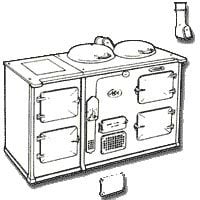

Model F stove 1936 – 1941
Originally known as Model 82 (it cost £82 at the time), but more generally referred to as Model F, this was the first four-oven AGA stove. It was distinguished from the other, and later, four-oven stove (Model E) by:
- The flue chamber, for which there were two types, one for horizontal and one for vertical connection.
- The small oblong ashpit door.
- The perforated lug-type ashpit door handle.
- The cover plate over a stabiliser in the auxiliary air inlet (in early editions this was grilled, whereas in later editions it was plain).
- The front rail which was held in extensions to the top plate.
Standardised AGA cooker
In 1941, all existing cooker models, both domestic and heavy duty, were withdrawn and in their place a range of units was introduced with standardised parts which were, to a large extent, interchangeable between the various models, and uniformity in styling was achieved.
The standard models C and E could be fitted with a 6 gallon water tank as an alternative, and front and top plates could be supplied plain where no tank was required, or with provision for the tank neck at the back left-hand corner of the top plate, and with the front plate drilled for the draw-off and drain-off taps.



Standard Model E cooker 1941 – 1972
The model E can be recognised by the same features which distinguish the standardised Model C from Model 47/10. In addition Model E had chromium plated lid domes in black vitreous enamel frames, though vitreous enamelled cast iron lids had to be resorted to for a time due to wartime and post war shortages.
In external appearance Model E was exactly the same as Model C with the two left-hand ovens, of which, as already mentioned, a few were installed soon after the standardised AGA was introduced. Model E can be easily recognised, however, by the two convection slots in the left-hand panel of the bottom right-hand (baking) oven.
Aga Standard Model CB cooker 1946-1972
Standard Model CB cooker 1946-1972
In 1946, a water heater was introduced which could be fitted into Model C, making it into Model CB. The external appearance remained the same except for the normal additions of:-
- The drain cock in the front plate at the bottom centre.
- The flow and return pipes.
- The inspection panel in the left hand side plate.
In some cases it was possible to make the flow and return connections through the back plate. If, in such cases, a drain cock was fitted in the return pipe instead of through the front plate and a plain left hand side plate was used, there would be no external differences at all between Model C and Model CB. Disregarding the flow and return pipes to the two models can then only be distinguished by the 8-barred grate and 40mm simmering plate plug in Model C compared with the 7-barred grate and 33mm plug in Model CB.
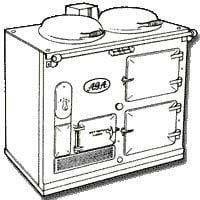

Standard Model C cooker 1941 – 1972
The standardised Model C is recognisable from its predecessor (which was normally referred to as Model 47/10) by the following main details:
- The restyled front plate and thermostat cover plates.
- The oblong grille over the auxiliary air inlet.
- The recessed front edge of the base plate.
- Both top and bottom oven doors of the same size.
- The heat gauge placed centrally in the front plate (instead of over the top oven door).
- The front rail in the early editions of the standardised models the front rail brackets were bolted to the top plate, whereas in later editions they have been modified to screw on the front plate.
- The square flue chamber which is adaptable for horizontal of vertical connection (in early editions this flue chamber was bolted on to the top plate, whereas it is now bolted to the flue manifold and a cut-out is left in the top plate to fit round it).



De Luxe Model C and CB cookers 1956 – Present
Introduced in 1956, the De Luxe Models are recognised by the following points:
- The chrome plated lid domes.
- The styled top plate, sloped to take a handrail.
- The raised splashback.
- Thermostat control at top left of front plate.
- Ashpit door covered by larger door similar to oven doors.
- Concealed flue chamber (under enamelled flue shroud).
- No conventional handrail brackets.
- Overlap on front plate over base plate.
- Restyled flat top plate outer ashpit door with louvre, new handrail brackets and oven doors with asbestos rope seatings introduced in May 1974 (Ceramic ropes 1980).



Standard Model E cooker 1941 – 1972
In 1946, a water heater was introduced which could be fitted into Model C, making it into Model CB. The external appearance remained the same except for the normal additions of:
- The drain cock in the front plate at the bottom centre.
- The flow and return pipes.
- The inspection panel in the left hand side plate.
In some cases it was possible to make the flow and return connections through the back plate. If, in such cases, a drain cock was fitted in the return pipe instead of through the front plate and a plain left hand side plate was used, there would be no external differences at all between Model C and Model CB. Disregarding the flow and return pipes to the two models can then only be distinguished by the 8-barred grate and 40mm simmering plate plug in Model C compared with the 7-barred grate and 33mm plug in Model CB.owners website.


De Luxe Model E cooker
Similar on all counts to the Model C and CB cookers, with the addition of two left hand ovens:
- Supplied with separate left-hand and right-hand top plates and handrails from November 1975.


Model GC, GCB, GE, GEB 1968 – Present
Introduced 1996.
- Suitable for Town Gas (up to 1988) LPG and Natural Gas.
- Burner design and controls upgraded in line with Open Flue Models (1988, 1993).
- Flue Terminal originally rectangular, then concentric (1974).
- Concentric flue terminal suitable for:- 9-14″ | 14-24″ | 24-36″ (since withdrawn) Wall thickness
- Oven venting by natural draught up to 1990.
- Fan assisted 1990.
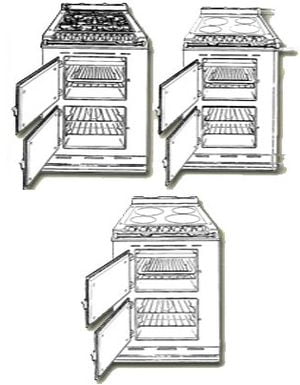

Module and Companion: Gas Hob 1998 – Present
Traditional AGA styling.
- Intended for linking to Parent AGA (Module) or as a freestanding appliance (Companion).
- Conventional oven and grill unit electrically heated.
- Fan assisted electric oven.
- Hob with 4 gas burners both Natural Gas and L.P.G variants.
